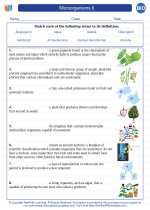Microorganisms II -> temperature
Temperature
Temperature is a measure of the average kinetic energy of the particles in a substance. It is a key factor in various biological processes and functions.
Importance of Temperature in Biology
- Enzyme Activity: Temperature affects the rate of enzymatic reactions. Most enzymes have an optimum temperature at which they function most efficiently.
- Cell Membrane Fluidity: Temperature influences the fluidity of the cell membrane, which in turn affects the movement of molecules in and out of the cell.
- Metabolic Rate: Organisms have specific temperature ranges within which their metabolic processes occur optimally. Deviations from this range can affect the overall metabolic rate.
- Ecological Adaptations: Organisms have evolved specific adaptations to survive in different temperature conditions, leading to the concept of thermoregulation.
Measurement of Temperature
Temperature can be measured using various scales such as Celsius (°C), Fahrenheit (°F), and Kelvin (K). The Kelvin scale is commonly used in scientific research and is based on absolute zero, the theoretical lowest temperature possible.
Impact of Temperature on Organisms
Extreme temperatures can have detrimental effects on organisms. For example, high temperatures can denature proteins, while low temperatures can lead to the formation of ice crystals within cells, causing damage.
Study Guide
To understand the concept of temperature in biology, it is important to:
- Learn about the kinetic theory of matter and how it relates to temperature.
- Understand the role of temperature in enzyme function and its impact on biological reactions.
- Explore the mechanisms of thermoregulation in different organisms and how they adapt to varying temperature conditions.
- Compare and contrast the temperature scales and understand the significance of absolute zero in the Kelvin scale.
- Examine case studies and examples of how temperature affects biological processes in different organisms.
By mastering the concept of temperature in biology, you will gain a deeper understanding of the fundamental role it plays in the functioning and survival of living organisms.
[Temperature] Related Worksheets and Study Guides:
.◂Biology Worksheets and Study Guides High School. Microorganisms II

 Worksheet/Answer key
Worksheet/Answer key
 Worksheet/Answer key
Worksheet/Answer key
 Vocabulary/Answer key
Vocabulary/Answer key
 Vocabulary/Answer key
Vocabulary/Answer key
 Vocabulary/Answer key
Vocabulary/Answer key
 Vocabulary/Answer key
Vocabulary/Answer key
 Vocabulary/Answer key
Vocabulary/Answer key
